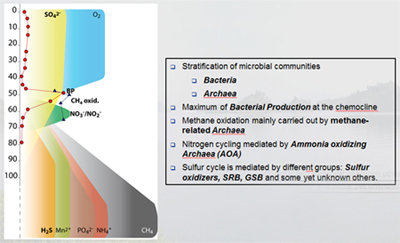MICKI
Lake Kivu is a meromictic lake located in the volcanic region
between Rwanda and the Kivu Provinces (D.R. Congo). Lake Kivu
has traditionally received considerable attention by limnologists
and geochemists due to the large amount of dissolved CO2 (~300
km3) and CH4 (~60 km3) that accumulate in deep waters as a result
of geological and biological activity (Schöell et al. 1988,
Schmid et al. 2005). It is then not surprising that most of the
research carried out in the lake has focused on the causes and
effects of methane accumulation, its temporal variation, risk
assessment and management (Schmid et al. 2002; 2005).
Several studies conducted so far on Lake Kivu have focused on
geochemistry and have been devoted to the lake’s physical
structure, the methane cycle and to microorganisms involved (e.g.
Jannasch 1975; Schöell et al. 1988; Pasche, 2009).
A recent study (CAKI FRFC project) performed by the three teams
involved in the MICKI project was devoted to carbon and nutrient
cycles, but no study has explicitly addressed so far the diversity,
distribution and activity of bacterial/archaeal communities in
the lake. This is of special interest after the compelling evidence
of the ubiquity and abundance of mesophilic archaea in a wide
variety of habitats (Chaban et al. 2006; Casamayor and
Borrego 2009).
Among the most ubiquitous archaeal groups discovered so far are
the ammonia oxidizing archaea (AOA), which have been consistently
found in soil and marine environments (Prosser & Nicol 2008),
raising questions about their impact on global C and N cycles.
According to recent data (Llirós et al. 2010),
the epipelagic waters of Lake Kivu harbour a diverse community
of archaea, being the ammonia oxidizing crenarchaeota the most
frequent phylotypes found at the oxic/anoxic transition zone during
the rainy season. These results suggested a potential contribution
of these microorganisms in N cycling in the lake although no activity
measurements have been conducted so far. In addition, the development
of Green Sulfur Bacteria (GSB) has been noted several times in
the hypolimnion that develops in the biozone during the rainy
seasons, through the detection of their specific pigments (bacteriochlorophyll
and bacterial carotenoids) associated to deep chlorophyll maxima
(Sarmento et al., 2008). Particularly high biomass of
GSB have been observed in the Kabuno basin, reflecting different
limnological conditions between basins.
Financement : Fonds National de la Recherche Scientifique (FRS-FNRS)
Réseau: coordination: J.-P.
Descy, Université de Namur
Partenaires: P. Servais, Université Libre de Bruxelles,
A.V. Borges, Université de Liège





